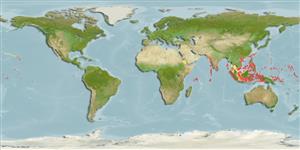>
Gobiiformes (Gobies) >
Gobiidae (Gobies) > Gobiinae
Etymology: Trimma: Greek, trimma, -atos = something crushed (Ref. 45335).
Eponymy: Dr Leighton R Taylor Jr (d: 1940) is a marine biologist who was Curator of Fishes (and later Director) at Waikiki Aquarium, Hawaii (1975–1986). [...] (Ref. 128868), visit book page.
Environment: milieu / climate zone / Tiefenbereich / distribution range
Ökologie
seewasser riff-verbunden; tiefenbereich 20 - 50 m (Ref. 54980). Tropical; 28°N - 8°S
Indo-Pacific: Maldives to Hawaiian and Society Islands; Japan to Australia (Queensland and Northwest Shelf); throughout East Indian region.
Size / Gewicht / Alter
Geschlechtsreife: Lm ? range ? - ? cm
Max length : 3.5 cm SL Männchen/unbestimmt; (Ref. 48637)
Rückenflossenstacheln (insgesamt) : 7; Rückenflossenweichstrahlen (insgesamt) : 10 - 11; Afterflossenstacheln: 1; Afterflossenweichstrahlen: 9 - 10. Males have longer dorsal spines and yellow spotting on the fins (Ref. 1602); characterized further by semi-translucent upper part of body, pinkish orange below; head and median fins with yellow orange spots; elongate and filamentous second dorsal spine; fifth pelvic ray branched, 75-85% length of fourth ray; longitudinal scale series 23-24; predorsal scales absent; cheek and opercle without scales; depth of body 4.0-4.2 in SL (Ref. 90102).
Body shape (shape guide): fusiform / normal; Cross section: compressed.
Benthopelagic (Ref. 58302). Occur in caves of drop-offs at depths of about 25 to at least 50 m (Ref. 48637, 58302). Form loose schools near the roofs or sides of caves and disappears into holes or crevices when approached. Often seen with other species of Trimma and feeds on harpacticoid copepods (Ref. 48637).
Life cycle and mating behavior
Geschlechtsreife | Fortpflanzung | Ablaichen | Eier | Fecundity | Larven
Myers, R.F., 1991. Micronesian reef fishes. Second Ed. Coral Graphics, Barrigada, Guam. 298 p. (Ref. 1602)
IUCN Rote Liste Status (Ref. 130435: Version 2024-2)
Bedrohung für Menschen
Harmless
Nutzung durch Menschen
Fischereien: nicht kommerziell
Tools
Zusatzinformationen
Download XML
Internet Quellen
Estimates based on models
Preferred temperature (Ref.
123201): 24.6 - 28.5, mean 27.9 °C (based on 85 cells).
Phylogenetic diversity index (Ref.
82804): PD
50 = 0.5000 [Uniqueness, from 0.5 = low to 2.0 = high].
Bayesian length-weight: a=0.01023 (0.00477 - 0.02194), b=3.01 (2.83 - 3.19), in cm total length, based on LWR estimates for this (Sub)family-body shape (Ref.
93245).
Trophic level (Ref.
69278): 3.0 ±0.00 se; based on food items.
Widerstandsfähigkeit (Ref.
120179): hoch, Verdopplung der Population dauert weniger als 15 Monate. (Preliminary K or Fecundity.).
Fishing Vulnerability (Ref.
59153): Low vulnerability (10 of 100).
🛈
Nutrients (Ref.
124155): Calcium = 263 [125, 647] mg/100g; Iron = 1.31 [0.62, 2.55] mg/100g; Protein = 18.1 [16.1, 19.9] %; Omega3 = 0.176 [0.070, 0.380] g/100g; Selenium = 27.9 [11.9, 62.9] μg/100g; VitaminA = 138 [36, 510] μg/100g; Zinc = 3.26 [1.98, 5.05] mg/100g (wet weight);
